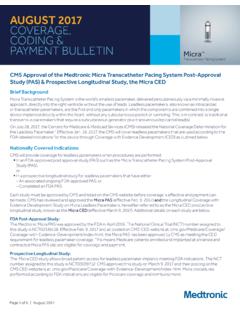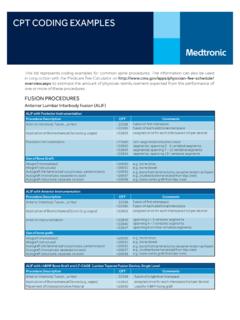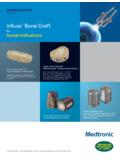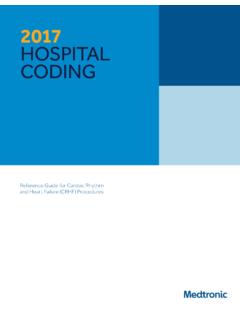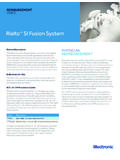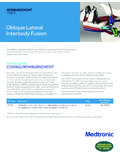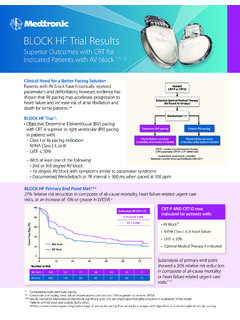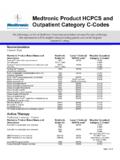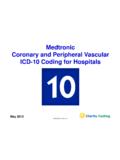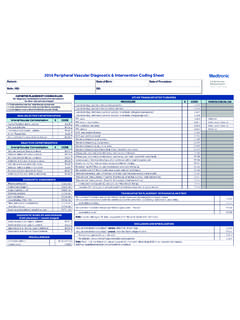Transcription of Melody - Medtronic
1 Proven Performance, Simply DeliveredMelody transcatheter pulmonary VALVE THERAPYI nformation for patients and their familiesAt Medtronic , our culture continually inspires us to push the boundaries of medical technology to help patients live better, longer lives. Melody transcatheter pulmonary Valve (TPV) Therapy demonstrates our commitment to providing innovative therapies for the lifetime management of patients with congenital heart disease. With Melody TPV Therapy, children and adults with failed pulmonary valve conduits have a proven treatment option designed to restore pulmonary valve function and delay the need for of patients from around the world have benefited from this booklet is provided to help you and your loved ones learn more about Melody transcatheter pulmonary Valve (TPV) Therapy.
2 Please discuss any questions with your heart doctor. Only your doctor can help you decide if Melody TPV is the right therapy for you. About The Heart.. 1 - 2 Congenital Heart Disease How The Heart Works What Heart valves DoPulmonary Valve Conditions And Conduit Failure ..3 - 4 pulmonary Valve Conditions pulmonary Valve Conduit Failure pulmonary Valve Conduit Failure SymptomsPulmonary Valve Conduit Failure Treatments ..5 Open-Heart Surgery Balloon Angioplasty transcatheter pulmonary Valve TherapyMelody transcatheter pulmonary Valve (TPV) Therapy.
3 6 About Melody TPV Therapy Is Melody Right For You? When Melody Isn t An OptionThe Melody TPV Procedure ..7 - 8 During The Procedure After The Procedure Follow-Up CareRisks And Benefits ..9 - 10 Possible Adverse Events Melody TPV Probable Benefits Important Information About Stent FractureAdditional Warnings And Precautions ..11 Warnings PrecautionsFAQs ..12 Frequently Asked QuestionsResources ..Backside Online Resources Medtronic LifeLine Technical SupportTable of ContentsThis therapy is not for everyone.
4 Please consult your physician. A prescription is required. For further information, please contact Medtronic at 1-877-526-7890. Please go to back page for important risk Heart DiseaseCongenital (from birth) heart disease (CHD) is the most common birth defect, affecting eight in one thousand infants born each year. There are many different types of CHD. Most have to do with a heart that doesn t develop like it should or with problems with the large blood vessels (the pulmonary artery, and/or aorta) connected to the heart. How The Heart WorksA healthy heart beats about 100,000 times a day and pumps about five quarts of blood each minute or 75 gallons (284 liters) of blood every normal heart has four chambers.
5 The upper two chambers are the right and left atria. The lower two chambers are the right and left ventricles. Blood is pumped through the four heart chambers with the help of four heart valves the tricuspid, pulmonary , mitral and aortic valves . The heart s job is to supply the body with oxygen-rich blood. First it sends blood without any oxygen to the lungs to get oxygen. It then returns it to the heart where the blood containing oxygen will be pumped to other parts of the ValveRight VentricleRight AtriumLeft AtriumAortaPulmonary ArteryLeft VentricleMitral ValveAortic ValvePulmonary ValveAbout The HeartWhat Heart valves Do Heart valves open when the heart pumps to allow blood to flow forward, and close quickly between heartbeats to make sure blood does not flow backward.
6 Any problem with this normal flow will make it difficult for the heart to effectively pump the blood where it needs to go. The tricuspid valve sits between the right upper chamber (right atrium) and the right lower chamber (right ventricle). The tricuspid valve directs blood flow from the right upper chamber to the right lower chamber. The pulmonary valve directs blood flow from the right lower chamber (right ventricle) into the pulmonary artery, which splits into two arteries so that the blood from the body can get to both lungs.
7 The mitral valve sits between the left upper chamber (left atrium) and left lower chamber. The mitral valve directs blood flow from the left upper chamber into the left lower chamber. The aortic valve directs blood from the left lower chamber (left ventricle) into the aorta. The aorta is the major blood vessel that leads from the left lower chamber to the rest of the ValveMitral ValveAortic ValvePulmonary ValvePulmonary Atresia A condition where the pulmonary valve is abnormal and does not open like it should. This means that blood cannot go to the lungs to pick up of Fallot A condition which refers to four heart defects that usually occur together; a hole between the right and left pumping chambers of the heart (ventricles), a narrowed path between the heart and the lungs, an artery (aorta) that is connected to the heart closer to the right side of the heart than normal, and a thicker than normal pumping chamber (ventricle) on the right side of the heart.
8 Double Outlet Right Ventricle A condition in which both main arteries, one that carries blood to the lungs ( pulmonary artery) and one that carries blood to the rest of the body (aorta), are connected to the right lower chamber of the heart (ventricle). Usually, the aorta is connected to the left lower chamber of the and adults with these conditions have narrowed pulmonary valves and need surgery for placement of a right ventricular outflow tract (RVOT) or pulmonary conduit. A pulmonary conduit is a tube that connects the heart to the lungs.
9 pulmonary Valve Conditions And Conduit Failure3 pulmonary Valve ConditionsIf your doctor has recommended that you read this booklet, you may have one of the following congenital heart conditions that most commonly affect the pulmonary valve: Symptoms of pulmonary Valve Conduit Failure Becoming tired or short of breath with activity Feeling tired, dizzy or too weak to do your normal activities Irregular heart beats or the feeling that your heart is racing or pounding in your chest Fainting or near faintingSymptoms can range from mild to severe.
10 If you are experiencing any of these symptoms, talk with your doctor. Regular check ups and testing can help determine how your pulmonary valve conduit is working. pulmonary Valve Conduit FailureOver time, mineral deposits may build up on the conduit (calcification), and it may become narrowed and/or leaky. This may happen as you outgrow the conduit or as the conduit wears out from the pressures of pumping blood or from calcium build Narrowed Conduit (Stenosis) The conduit opening is narrowed, which limits blood flow from the heart to the lungs and forces the heart to work harder than normal.
